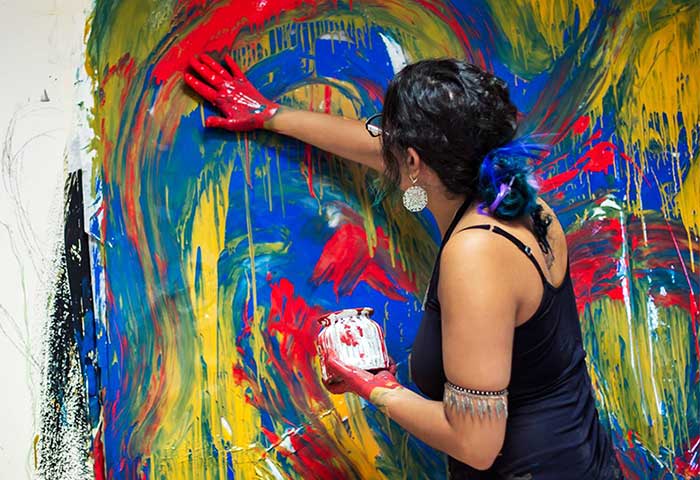[ad_1]
Madhubani paintings are originated from the Mithila region of Nepal and India. Mostly practiced by women of the villages to decorate their huts made up of mud during the festive occasions. The art has been changing from the old times and nowadays the painting has been done on canvas, cloth, and paper. As the time passes by, the painting began turning into a piece of merriment and extraordinary occasions. Gradually the painting of India crossed the conventional limits and began achieving authorities of workmanship, both at the national and the global level.
The ladies from this district have been rehearsing society expressions since the 1800’s. The moms have been passing their insight and lessons to their little ones & showing them the aesthetic examples and colors minimal known to the outside world.
The Making
Madhubani paintings are created from natural colors such as ocher, charcoal soot, flowers, turmeric, sandalwood, apple and banyan tree leaves and paste of powdered rice. Painting is finished with the help of twigs, fingers, and brushes.
Themes of the Painting
The portrayed are designed in geometrical forms. The mostly drawn themes belonged to nature such as sun, moon, holy plants tulsi, flowering plants, birds and animals for filling the gaps in between the images. Along with Hindu deities such as Shiva, Rama, Krishna, Durga, Lakshmi and Saraswati During some important and auspicious events like marriages, childbirth and festivals such as Holi, Diwali, Durga Pooja, Surya Pooja etc.
3 different styles of Madhubani painting
The art form of Madhubani is divided into three famous styles according to their caste system
1. Brahman: Being highest in the caste the Brahmins ladies were allowed to designs and color their painting using the bright hues. Making the religious portrait of god and goddesses. Due to their easy access to all holy text, it got much easier for them to make religious and mythological motifs.
2. Kayastha: The Kayasthas are on the second in the caste system after Brahmans. As we all know Kayastha are believed to be great warriors and braves. They got the style of painting and showcasing fertility. Animals and flowering plants including holy animals, birds, and plants such as lotus, parrot, peacock, fish and tortoise.
3. Dusadh: The third and lower caste in the hierarchy of caste system. The Dusadh people were not allowed to use any sort of religious motifs in their paintings. Their style of painting is otherwise called Tattoo or Godhana painting. Regular themes of vegetation can be found in their specialty. With time as the social acknowledgment broadened, they have now begun painting themes of divine god and goddesses. And nowadays their utilisation of dynamic hues is very like the Brahmin style of painting.
Advancement
All around known as the ladies’ craft, today the innovative world sees a sexual orientation, move where men are seen adding their imaginative touch to this conventional artistic expression. In current circumstances, form masters are back-pedalling to the rich material legacy of this workmanship and resuscitating this craftsmanship by outlining Madhubani sarees, dupattas, and the Indo-western dresses.
At various fashion weeks, fashioners have exhibited shading filled gathering of Madhubani outlines. From sarees, salwar kameez, long skirts, and palazzo jeans are wonderfully planned in Madhubani workmanship.
Expectedly, this craftsmanship was done to beautify and add hues to homes. In any case, with evolving times, it is currently even done on high-quality paper-mâché items and divider works of art. Paper stands, magazine case, games like Ludo, and adornments boxes made of papier-mâché, book marks, stamps and wall hanging are painted with Madhubani outlines.
Foreign Scholars investment in promoting Madhubani Painting
The foreign scholars have played a significant role in advancing the artistic painting globally likewise was gigantic. The very first person to visit Mithila and promote the art was a French journalist and author Yves Vequad, in the mid-1970s. His exploration created a book and a film, The Ladies Painters of Mithila. He was soon trailed by the German anthropologist and folklorist Erika Moser. Moser and Raymond Lee Owens, an American who set up the Master Craftsmen Association of Mithila in 1977. The association is still running and gives the craftsmen of the Mithila a standard salary through presentations, and deals with gatherers and craftsmanship exhibitions. In Japan, there is a gallery called ‘Mithila Historical centre which has more than 850 Madhubani work of Art is showcased.
Fascinating Actualities
The legacy of Madhubani workmanship is no less than 2,500 years; however, it is amid the previous decade that this craftsmanship has increased much noticeable quality and is being commended in the design world. The specialty of Madhubani paintings and creativity of the artist is renowned in India as well as appreciated by the people all over the world.
[ad_2]
Source

